| Oracle® Fusion Middleware User's Guide for Oracle B2B 11g Release 1 (11.1.1.6.0) Part Number E10229-07 |
|
|
PDF · Mobi · ePub |
| Oracle® Fusion Middleware User's Guide for Oracle B2B 11g Release 1 (11.1.1.6.0) Part Number E10229-07 |
|
|
PDF · Mobi · ePub |
The appendix contains the following topics:
Oracle B2B provides synchronous request/response between from Fabric to Oracle B2B. However, only HTTP transport is supported for the initial release. Figure B-1 shows the end-to-end scenario.
To configure the sender, you need to perform the following tasks:
You need to use B2B Configuration Wizard in Oracle JDeveloper to configure the sender for synchronous request/reply support:
In the Operations page of B2B Configuration Wizard, select Synchronous Request/Reply option, and then select Outbound as shown in Figure B-2.
Figure B-2 B2B Configuration Wizard: Operation Page
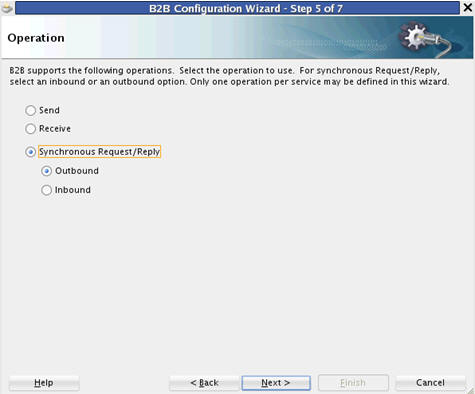
In the Document Definition page of B2B Configuration Wizard, specify the definitions for both Request and Reply.
The Routing ID selection only appears for the Request document. The Response is returned to Fabric on the same request call, so no Routing ID is required to route the response as shown in Figure B-3.
Figure B-3 B2B Configuration Wizard: Document Definition Page
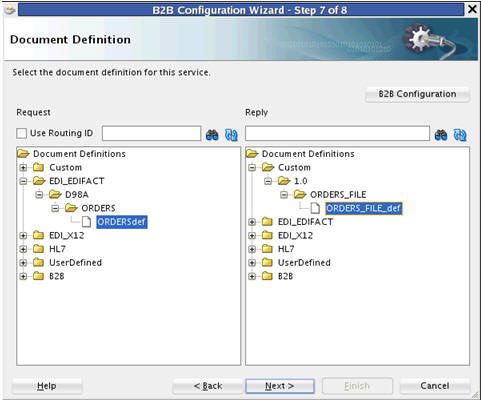
In Oracle B2B console, you need to:
Set up Oracle B2B agreements: You need to define two agreements. One agreement is required to send the Request, and the other agreement is needed to receive the Response as shown in Figure B-4. You do not need to set up any Oracle B2B property for this. Based on the call from the Fabric to Oracle B2B, the message type "sync request" is determined.
Figure B-4 Setting Up Oracle B2B Agreements
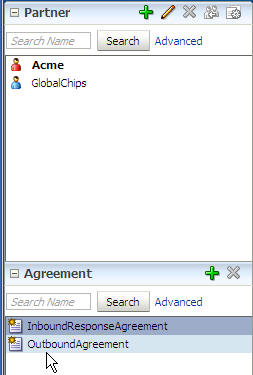
Create a Trading Partner channel: You need to create a remote Trading Partner Channel to point to http://server:port/b2b/syncreceiver as shown in Figure B-5. This is required if the communication is between two Oracle B2B products. Please note that the URL will be different if the communication takes place between two different B2B products.
Figure B-5 Creating a Trading Partner Channel

To configure the receiver, you need to perform the following tasks:
You need to use B2B Configuration Wizard in Oracle JDeveloper to configure the receiver for synchronous request/reply support:
In the Operations page of B2B Configuration Wizard, select Synchronous Request/Reply option, and then select Inbound as shown in Figure B-6.
Figure B-6 B2B Configuration Wizard: Operation Page
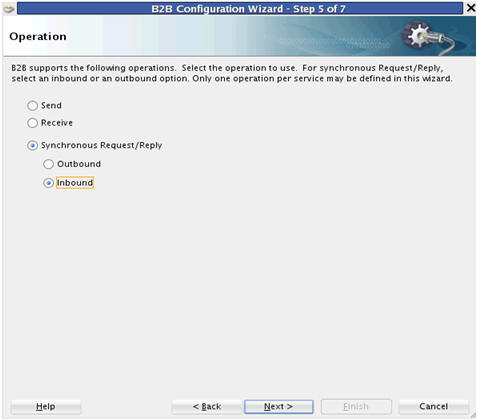
In the Document Definition page of B2B Configuration Wizard, specify the definitions for both Request and Reply.
The Routing ID selection only appears for the Request document. The Response is returned to Fabric on the same request call, so no Routing ID is required to route the response as shown in Figure B-7.
Figure B-7 B2B Configuration Wizard: Document Definition Page

In Oracle B2B console, you need to:
Set up Oracle B2B agreements: You need to define two agreements. One agreement is required to recieve the Request, and the other agreement is needed to send the Response as shown in Figure B-8. You do not need to set up any Oracle B2B property for this. The synchronous HTTP receiver decides the message type as "sync request".
Figure B-8 Setting Up Oracle B2B Agreements
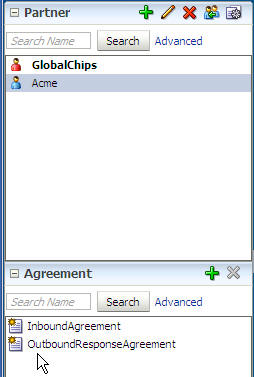
Create a dummy Trading Partner channel: You need to create a dummy remote Trading Partner Channel, but this channel is not used at run time. You can specify any URL value, but the value needs to be in the format http://host:port/xyz as shown in Figure B-9.
Figure B-9 Creating a Dummy Trading Partner Channel

Synchronous request or response resubmit must be done from the Application side. Although the Oracle B2B console allows resubmit of Application or Wire messages from Oracle B2B, however, it resubmits the messages in the as nonsynchronous mode. Sometimes, the message processing logic is nondeterministic. For example, if an Application or a Wire message is resubmitted from Sender side Oracle B2B, the message is posted to http://server:port/b2b/syncreceiver. The Receiver Oracle B2B processes the message as synchronous request or response. The response message on the Sender side is ignored.